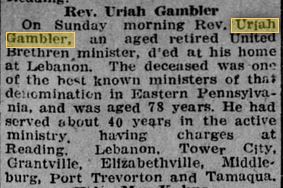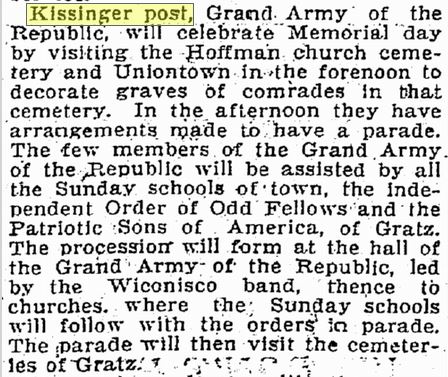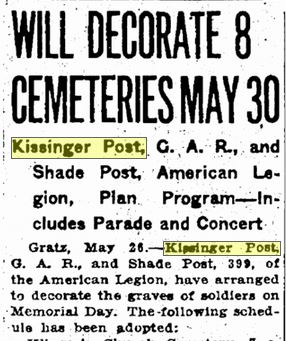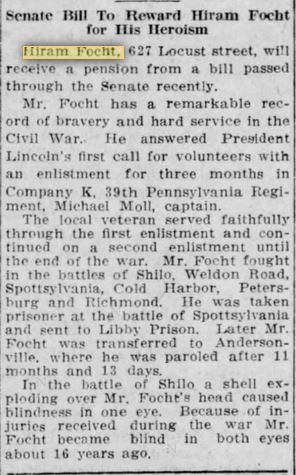Posted By Norman Gasbarro on December 18, 2015

Three Harrisburg Men Capture Confederate Spy in the River
Col. Demming and Simon Gratz Who Caught “Rebel” Will Meet on Fiftieth Anniversary of Event
According to Samuel Bates, an incident occurred on the Susquehanna River, south of Harrisburg, on 2 July 1863, while the Battle of Gettysburg was taking place, in which three Union men captured a Confederate spy on the river. The person who was captured was found to have in his possession a map of the river, was wearing what appeared to be a cavalry jacket decorated with orange colored material, and had a loaded revolver in his possession. After he was turned over to the Provost Marshal of the District, he was reportedly released, but then as he allegedly tried to cross into Confederate lines, he was re-captured and sent to the Union prison at Fort Delaware. This story needs some serious fact checking.
One of the three Union men involved in the initial capture of this “spy” was Simon Gratz (1842-1923), the son of Theodore Gratz (first mayor of Gratz, Pennsylvania), and the grandson of the Simon Gratz who is credited with laying out the town of Gratz and for whom the borough is presently named. Although Simon Gratz was born in Harrisburg, the family moved to Gratz, where he spent part of his youth, including attending school, before the family returned to Harrisburg where his father Theodore died in 1863.
Simon Gratz has documented service in three Civil War regiments.

According to the Pennsylvania Archives (above card), his first service occurred when he was mustered into the 2nd Pennsylvania Infantry, Company I, as a Private, on 11 May 1861. There is no muster out date in the records and the unusual things about the card shown above are that not only is there no muster out date given, but the entire company was mustered in on 11 April 1861 – one month prior to the date on which Simon Gratz joined the regiment.

The second service for Simon Gratz is supposedly in the 127th Pennsylvania Infantry, Company A, as a Corporal. In that company, he was mustered into service as “Samuel Gratz” on 26 July 1862 and mustered out of service on 8 May 1863.
His third service was as Captain in the 57th United States Colored Troops from 10 March 1864 through 13 December 1866. The service of Simon Gratz in this regiment of African Americans is complicated as is the history of that regiment, but he can be accounted for during the time frame in which he was credited with service.
Thus, it is likely from the time frame given above that Simon Gratz could have been at home in Harrisburg during the Battle of Gettysburg, when the alleged spy incident took place. But, was he part of an official company guarding Harrisburg and the Susquehanna River area, and did the incident actually take place? No service record has been located for Simon Gratz in an emergency militia regiment called into service by Governor Andrew Curtin during the time of the Confederate invasion of Pennsylvania in 1863.
Two slight variations of the spy-capture story have been found. The earliest was said to have appeared in the Harrisburg Telegraph on 2 June 1863. The second, was attributed to Corporal H. C. Demming, who gave his account to Samuel Bates who printed it as part of a footnote on pages 1227-1228 of Volume 5 of History of the Civil War, the state’s officially commissioned war history. The first version was reprinted by the Harrisburg Telegraph on 1 July 1913, the 50th anniversary of the Battle of Gettysburg, as part of a story about Simon Gratz and his return to Harrisburg for the 50th reunion of the spy-capture incident.
The two versions are presented below for readers to judge their veracity.
The Harrisburg Telegraph version:
The Spy Captured
About 4 o’clock this morning while a squad of F. Asbury Awl‘s company were doing duty in Harrisburg, guarding the ford and —–, a flat boat was discovered —– down stream containing what was supposed to be a man. The guard ordered the person who was on board to stop the craft, but not being obeyed, he fired.
This had the effect of causing the occupant of the boat, which by the way, had struck a rock and stuck fast, to dodge down and secrete himself in the hold. He was warned to get up and run his boat into shore where the guard was stationed, but not complying, a second shot was fired at the boat.
This had no effect, and the corporal of the guard, accompanied by Sergeant Gratz, of the same company, took possession of a boat lying along the shore and pulled out to the flat. On nearing the flat, it presented a deserted appearance, but when the craft came alongside, lo and behold! a man with the uniform of a cavalry officer, and wearing captain’s straps, was discovered cramped in one corner.
He was arrested and ordered to leave the flatboat and get into the boat alongside. This he did but not without remonstrating some time with his captors, protesting against being arrested. When the party reached the shore the pretended officer was searched and a loaded “shooter” and a new hatchet were taken from him. He was then escorted before Captain Awl, who ordered the corporal of the guard to take him to the Provost Marshal’s office.
Uniform Taken Off
This was about 4:30 o’clock, but the Provost Marshal’s office being closed, the guard took him to his room in the Jones’ House. He was kept under guard until the office opened and taken before the marshal. A brief statement was made by one of his captors and sent to General Couch. The General ordered his uniform to be taken off, and he is now minus his uniform.
We would suppose this man to be a spy from the conflicting statements which he made and from the map of the Susquehanna, with many of its principal fords, which was found in his possession.
Note: The original article which supposedly appeared in the Harrisburg Telegraph on 2 July 1863 has not yet been located for comparison to the re-printed version. The gaps [“—–“] in the re-printed version (above) are due to a torn copy of the newspaper that was scanned.
The version given to Bates by Henry C. Demming:
In reply to your note of inquiry of the 8th of May, I write. I was on duty in Harris Park, below the Cumberland Valley Railroad Bridge, on the night of July 1st, 1861, as one of the Corporals of the sentry, stationed along the river bank. At about day-break on the morning of the 2nd, Private C. DeHart, discovered floating down the river, what he at first took to be a log. When it had floated nearly opposite to his post, he thought he could see the faint outline of a man aboard what he now discovered to be a flat-boat, although it was about two hundred feet from shore, He cried “halt” but no movement was made by the man in the boat, and DeHart fired. Several of the sentries now aimed at the object, and it dropped within the flat in time to escape one or two additional shots. I immediately ran for a skiff some distance up the bank, but it was fastened to a large rock. Sergeant Simon Gratz came to my assistance, and we succeeded in lifting the rock into the boat and pushing to the flat. There, crouched in one corner, we discovered a man, who, on seeing us, immediately sprang to his feet. He was armed, but found that resistance was useless, and after a short parley he surrendered. An examination of the flat showed that he had thrown a weight over the stern, fastened in such a manner, that upon floating down the main channel of the Susquehanna, and passing over a spot where the water was not over three or four feet deep, it would drag, and the place could be noted. He was floating over the ford below the bridge, when the sentry fired, and just as the man fell to the bottom of his boat, the weight of the stern struck a shoal place and stopped the flat.
He was taken to the shore, but protested against his summary arrest, and claimed to be a member of General Couch’s staff. He was registered at the Jones House, Harrisburg. When captured, he had on a cavalry jacket, trimmed with orange colored material, with a cavalry Captain’s straps. He surrendered to me a new hatchet and revolver, the latter carefully loaded. When searched in the office of Captain John Kay Clement, the Provost Marshal of the District, I am informed a map of the Susquehanna was found on his person, containing a number of fords of the Susquehanna, above and opposite the city, For some reason that I never could understand, he was released on the same or the next day, He was re-captured withing forty-eight house thereafter, in the act of crossing our lines to join the rebels. After his re-capture, he was sent to Fort Delaware.
When captured the first time, he told me while I was taking him to the Provost Marshal’s office, that he had a horse or two on the island near the Cumberland Valley shore, nearly opposite Independence Island, I was sent there with Sergeant Gratz, and Private J. J. Rebman, a day or two after, but the animals were gone. They had evidently been taken away hurriedly, as part of the bridle rein was still fastened to the tree, having either been cut from the bridle or broken off. Had he succeeded in eluding capture on the morning of the 2nd, he would have returned to the enemy, with full knowledge of the fords of the Susquehanna, and the number of troops in the city and vicinity.
Respectfully submitted with accompanying papers.
The reprinting of the article that appeared in the Harrisburg Telegraph on 2 July 1863, was prompted by a letter sent by Simon Gratz to the editor, 27 June 1913:
Letter from Mr. Gratz
1950 N. 23rd Street, Philadelphia, Pennsylvania
27 June 1913
Dear Sir:
On 2 July 1863 you published an account of the capture of a Confederate spy on the Susquehanna River by John DeHart, Harry Demming and Simon Gratz.
As I am coming through Harrisburg 1 July, it will afford me much pleasure to see either of the above men.
An information you can give me about John DeHart and Harry Demming, where they may be found, etc., will be appreciated.
An account of the capture can be found in Bates’ History of the Civil War, Volume 5, Page 1228.
Very truly yours,
Simon Gratz
In its article of 1 July 1913, the Harrisburg Telegraph described the upcoming reunion:
Fifty years ago three Harrisburg men, members of Asbury Awl‘s company of citizen soldiers, effected the capture of a spy who was making a map of the fords in the Susquehanna River at South Harrisburg, Maclay Street and Rockville. Tomorrow two survivors of the party will have an informal reunion of the event. They are Simon Gratz, of Philadelphia, and Colonel Henry C. Demming , of this city.
The third member of the party, John DeHart, who formerly lived in Mulbery Street, is dead.
Recently, the Telegraph received… [a] letter from Mr. Gratz…. Colonel Demming immediately put himself in touch with his old comrade of Philadelphia.
Mr. Gratz will arrive in Harrisburg tomorrow and will call on his comrade of Civil War days to renew old acquaintanceship.
The first way to fact check this story is to determine whether any of the characters mentioned were in a militia regiment captained by Francis Asbury Awl in 1863. The index card shown below, from Fold3, references a independent militia group in which F. Asbury Awl was the Captain:

Finding a list of the members of this company and its dates and place of service is the next step. In checking the index cards available at the Pennsylvania Archives, no card was found for F. Asbury Awl for this independent company. The cards at the Pennsylvania Archives are an index to Bates, and a card not found could indicate that Bates did not credit F. Asbury Awl with service in this independent company and therefore there would be no list of soldiers or dates of service in Bates. A second place to look is Pennsylvanians in the Civil War by Steve Maczuga. In searching for “Awl”, no independent regiment or company comes up in the results. Private John Dehart did serve in an independent company in 1863, but his service was from 20 August to 23 February 1864, and did not cover the time of the Battle of Gettysburg. Henry C. Demming is not found in any independent regiment, and neither is Simon Gratz.
A search in the Union Records, Pennsylvania Index Cards, on Fold3, using the keyword “Awl’s Co” produced 93 cards, but none with the names Demming, Gratz, DeHart, or Rebman, the surnames given in the story told above. It would be possible for some enterprising individual to compile a list of the 93 persons supposedly members of this company (as indicated on the cards) and their ranks, but since the key names do not appear, it becomes more questionable whether the men ever served in Awl’s company. Also, there are no dates of service on the cards, so it can’t be determined from the cards whether the company was in service at the time of the Battle of Gettysburg.
A search of the Pension Index Cards on Fold3 for “Awl’s Company” produced only two cards where veterans claimed service in this regiment. Of the two men, only one, LaRue Lemur, had dates of service on the card, and from the dates given, mustered in on 28 May 1862 to discharge on the same day, it appears that this company was only in service for one day and had no relevance to the Battle of Gettysburg.
Awl died in 1904, nearly ten years before the story re-surfaced that a Confederate spy was captured by members of his company, so he would not have been around to prove or refute it.

The Pension Index Card for Simon Gratz (shown above in the Fold3 version), does not indicate service in any independent or emergency regiments or companies, but does include service in an Arkansas Infantry regiment, which is one of the complications in describing his service in the United States Colored Troops. An explanation of that complication will have to be reserved for a later date, as it has nothing to do with any service on or around the time of the Battle of Gettysburg. [Note that Simon Gratz died on 1 June 1923, in Philadelphia, as stated on the card.]
The presence of a military index card for F. Asbury Awl suggests that there is an official list of the men who were mustered into service in the Awl’s independent militia. But that list has not yet appeared on Ancestry.com with other original muster lists that are gradually being uploaded. The cards found on Fold3 were compiled by Federal government clerks in the 19th Century from those original muster sheets and serve as indexes to the muster sheets as well as summaries of the individual service of the veterans. As derivative or secondary sources, there could be errors on the cards (or missing cards) so the most conclusive and reliable evidence is the original muster sheets.
The naming of Provost Marshal John Kay Clement and his participation in this event could indicate that the official records of his office could contain reference to the spy incident. Those official records are available at the Philadelphia Branch of the National Archives. There is a finding aid to the many boxes of un-indexed Provost Marshal records and anyone wishing to look through those records for some reference to the incident would have to make an appointment at the Philadelphia Branch and dedicate a sufficient amount of time to going though the appropriate boxes, page by page, using appropriate procedures for the handling and copying of original documents.
Another matter in fact checking this story is determining the name of the alleged spy who was captured, released, and then recaptured, and finally sent to Fort Delaware. That name has not surfaced in any of the published accounts of the incident.
A good map of the Susquehanna River area in 1862, Harrisburg and south, can be found on-line at the Pennsylvania Archives. The area in question can be found on the black and white map tile (click on tile to open the map as a pdf).
Continued research on each of the men named in the above incident is also essential to determine their reliability as well as the possibility and probability that they were in Harrisburg at the time of the alleged incident.
Finally, it should be mentioned before closing that Simon Gratz was involved in several other questionable incidents involving his military experience, one of which occurred in 1873, when he was the only known survivor of an expedition to free the island of Cuba from Spanish rule. In 1905, when he was a street car conductor in Philadelphia, he made a claim against Cuba asking for compensation for his 1873 efforts, for which he was eventually awarded a pension. That story will have to wait until another day to be told.
Readers are invited to provide any thoughts and additional information by adding comments to this post or by sending information via e-mail. A picture is needed of Simon Gratz (1842-1923) so if anyone knows where one can be obtained, please indicate.
———————————–
Note: The Simon Gratz described in this blog post was not the same Simon Gratz who was President of the Philadelphia Board of Education and who was profiled in the post, “Was Simon Gratz a Civil War Veteran?” Simon Gratz High School was named after the latter, who was the son of Edward Gratz, brother of Theodore Gratz, the father of the former. The two Simon’s were first cousins, with the same paternal grandfather, Simon Gratz, who was the founder of Gratz, Pennsylvania.
Transcripts of the news articles mere made from images available on Newspapers.com.
Category: Research, Stories |
1 Comment »
Tags: African American, Andrew Curtin, Gratz Borough. Gratz family
 ;
;


































